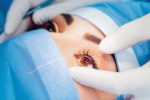5 Steps to Prevent Diabetic Eye Disease

The numbers are staggering! Estimates are that 600 million people will have some sort of diabetic retinopathy by 2040, making recognitions such as Diabetic Eye Awareness Month more important than ever. Glaucoma and cataracts also are more common in individuals with diabetes.
In fact, recent studies have revealed low awareness of the issue, indicating that many Americans may not be doing all they can to protect their vision from diabetes-related vision loss. Individuals with poor blood sugar control, women who are pregnant, and people with high blood pressure, high blood lipids or both are at increased risk for diabetic retinopathy, as are certain ethnic groups, including Hispanics, African-Americans and Native Americans.
Fortunately, according to the Centers for Disease Control and Prevention (CDC), about 90 percent of diabetes-related vision loss can be prevented, but early detection is key. And while new research is looking at developing diagnostic tools, including artificial intelligence and biomarkers, which could detect diabetic retinopathy early on, at the moment, there’s no substitute for rigorous testing via diabetic test strips and vision screening and disease prevention.
The American Academy of Ophthalmology recommends these five steps to help prevent diabetic-related eye disease:
1. Get a comprehensive dilated eye examination at least once a year. In its early stages, diabetic eye disease often has no symptoms. A dilated eye exam allows for thorough examination of the retina and optic nerve for signs of damage before you notice any changes to your vision. Monitoring your eyes’ health regularly makes it possible to begin treatment as soon as possible if signs of disease do appear.
2. Control your blood sugar. When blood sugar is too high, it can affect the shape of the eye’s lens, causing blurry vision, which returns to normal after blood sugar stabilizes. High blood sugar can also damage the blood vessels in the eyes. Maintaining good blood sugar control can help you prevent these problems.
3. Maintain healthy blood pressure and cholesterol levels. High blood pressure and high cholesterol can add to the risk for eye disease and vision loss. Managing both closely can reduce the risk of vision loss.
4. Quit smoking. If you smoke, your risk for diabetic retinopathy and other diabetes-related eye diseases is higher. Giving up tobacco can help reduce that risk.
5. Exercise. Regular exercise not only helps you manage your activity, weight and diabetes, but when you’re healthier, your eyes are too.
And finally, establish a relationship with an ophthalmologist who is aware of the latest clinical practice guidelines from the American Diabetes Association and can help you monitor your vision. Early identification is key to early treatment, reducing the risk of diabetes-related vision loss.






